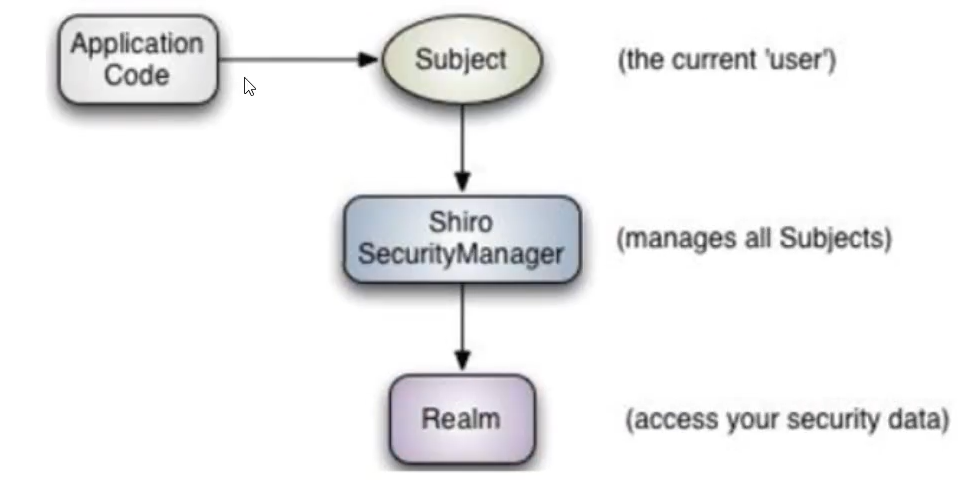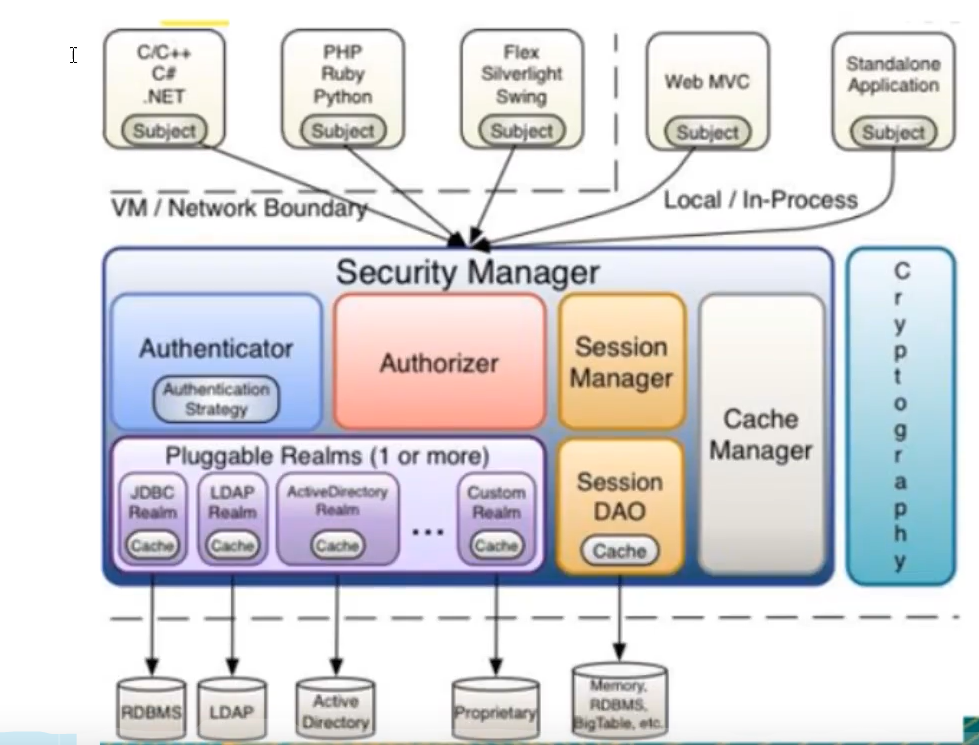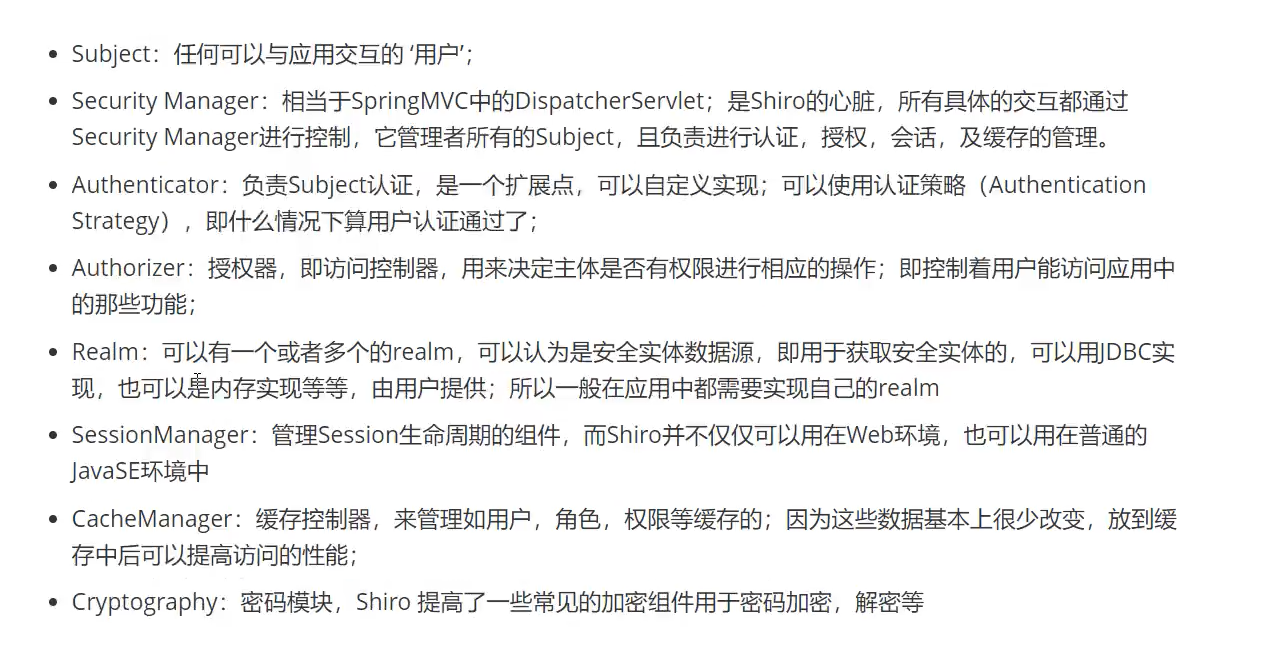1.1什么是Shiro
1.Apache Shiro是一个java的安全(权限)框架
2.JavaSE和JavaEE都可以使用
3.shiro作用在认证,授权,加密,会话管理,Web集成,缓存等
4.下载地址:https://shiro.apache.org
2.shiro架构(外部)
从应用程序角度来观察如何使用shiro完成工作:


3.shiro架构(内部)


4.quick start
4.1导包
<dependencies> <!-- https://mvnrepository.com/artifact/org.apache.shiro/shiro-core --> <dependency> <groupId>org.apache.shiro</groupId> <artifactId>shiro-core</artifactId> <version>1.7.0</version> </dependency> <!-- configure logging --> <!-- 日志门面--> <dependency> <groupId>org.slf4j</groupId> <artifactId>jcl-over-slf4j</artifactId> <version>1.7.26</version> </dependency> <dependency> <groupId>org.slf4j</groupId> <artifactId>slf4j-log4j12</artifactId> <version>1.7.26</version> </dependency> <dependency> <groupId>log4j</groupId> <artifactId>log4j</artifactId> <version>1.2.17</version> </dependency> </dependencies>
注意:slf4j和log4j的兼容版本去去maven仓库查看或者去shiro官网查看
4.2静态资源配置文件和QuickStart类复制官网的即可
import org.apache.shiro.SecurityUtils; import org.apache.shiro.authc.*; import org.apache.shiro.config.IniSecurityManagerFactory; import org.apache.shiro.mgt.DefaultSecurityManager; import org.apache.shiro.mgt.SecurityManager; import org.apache.shiro.realm.text.IniRealm; import org.apache.shiro.session.Session; import org.apache.shiro.subject.Subject; import org.apache.shiro.util.Factory; import org.slf4j.Logger; import org.slf4j.LoggerFactory; /** * Simple Quickstart application showing how to use Shiro's API. * * @since 0.9 RC2 */ public class Quickstart { private static final transient Logger log = LoggerFactory.getLogger(Quickstart.class); public static void main(String[] args) { DefaultSecurityManager securityManager = new DefaultSecurityManager(); IniRealm iniRealm = new IniRealm("classpath:shiro.ini"); securityManager.setRealm(iniRealm); SecurityUtils.setSecurityManager(securityManager); // get the currently executing user: //获取当前的用户对象suject Subject currentUser = SecurityUtils.getSubject(); // Do some stuff with a Session (no need for a web or EJB container!!!) //通过当前用户拿到session Session session = currentUser.getSession(); session.setAttribute("someKey", "aValue"); String value = (String) session.getAttribute("someKey"); if (value.equals("aValue")) { log.info("Retrieved the correct value! [" + value + "]"); } // let's login the current user so we can check against roles and permissions: //判断当前用户是否被认证 if (!currentUser.isAuthenticated()) { //Token:令牌 UsernamePasswordToken token = new UsernamePasswordToken("lonestarr", "vespa"); //设置记住我 token.setRememberMe(true); try { currentUser.login(token);//执行登录操作~ } catch (UnknownAccountException uae) { log.info("There is no user with username of " + token.getPrincipal()); } catch (IncorrectCredentialsException ice) { log.info("Password for account " + token.getPrincipal() + " was incorrect!"); } catch (LockedAccountException lae) { log.info("The account for username " + token.getPrincipal() + " is locked. " + "Please contact your administrator to unlock it."); } // ... catch more exceptions here (maybe custom ones specific to your application? catch (AuthenticationException ae) { //unexpected condition? er ror? } } //say who they are: //print their identifying principal (in this case, a username): log.info("User [" + currentUser.getPrincipal() + "] logged in successfully."); //test a role: if (currentUser.hasRole("schwartz")) { log.info("May the Schwartz be with you!"); } else { log.info("Hello, mere mortal."); } //粗粒度 //test a typed permission (not instance-level) if (currentUser.isPermitted("lightsaber:wield")) { log.info("You may use a lightsaber ring. Use it wisely."); } else { log.info("Sorry, lightsaber rings are for schwartz masters only."); } //细粒度 //a (very powerful) Instance Level permission: if (currentUser.isPermitted("winnebago:drive:eagle5")) { log.info("You are permitted to 'drive' the winnebago with license plate (id) 'eagle5'. " + "Here are the keys - have fun!"); } else { log.info("Sorry, you aren't allowed to drive the 'eagle5' winnebago!"); } //注销 //all done - log out! currentUser.logout(); //结束 System.exit(0); } }
5,subject相关的方法(从quickStart中得到)
//获取当前的用户对象suject Subject currentUser = SecurityUtils.getSubject(); //通过当前用户拿到session Session session = currentUser.getSession(); //认证 currentUser.isAuthenticated() //获取认证标识 currentUser.getPrincipal() //授予当前用户角色 currentUser.hasRole("schwartz") //获得当前用户的权限,根据给定的参数不同,获得的东西不同 currentUser.isPermitted("winnebago:drive:eagle5") //注销 //all done - log out! currentUser.logout(); //结束 System.exit(0);